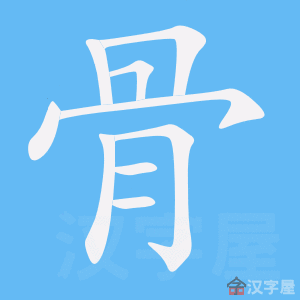|
骨病
gǔ bìng
|
osteopathy
|
|
骨瘤
gǔ liú
|
osteoma (benign tumor composed of bone-like material)
|
|
骨碌
gū lu
|
to roll rapidly;
to spin;
Taiwan pr. [gu2 lu5]
|
|
骨血
gǔ xuè
|
flesh and blood;
one's offspring
|
|
骨针
gǔ zhēn
|
spicule (in biology);
bone needle (in archaeology)
|
|
髌骨
bìn gǔ
|
kneecap;
patella
|
|
白骨精
bái gǔ jīng
|
White Bone Spirit (in the novel Journey to the West 西遊記|西游记[Xi1 you2 Ji4]);
(fig.) sly and cunning person
|
|
筛骨
shāi gǔ
|
ethmoid bone (cheek)
|
|
花骨朵
huā gǔ duo
|
(coll.) flower bud
|
|
虎骨
hǔ gǔ
|
tiger bone (used in TCM)
|
|
骨子
gǔ zi
|
ribs;
frame
|
|
正骨
zhèng gǔ
|
bonesetting;
Chinese osteopathy
|
|
听骨
tīng gǔ
|
ossicles (in the middle ear);
also written 聽小骨|听小骨
|
|
软骨鱼
ruǎn gǔ yú
|
cartilaginous fish (such as sharks)
|
|
铭心刻骨
míng xīn kè gǔ
|
engraved in one's heart and carved in one's bones (idiom); to remember a benefactor as long as one lives;
undying gratitude
|
|
锤骨
chuí gǔ
|
malleus or hammer bone of middle ear
|
|
风骨
fēng gǔ
|
strength of character;
vigorous style (of calligraphy)
|
|
骨节
gǔ jié
|
joint (of the skeleton)
|
|
骨肉相连
gǔ ròu xiāng lián
|
lit. interrelated as bones and flesh (idiom); inseparably related;
closely intertwined
|
|
骨董
gǔ dǒng
|
variant of 古董[gu3 dong3]
|
|
骨骼肌
gǔ gé jī
|
striated muscle
|
|
一骨碌
yī gū lu
|
with a rolling or twisting movement;
in a single movement;
in one breath
|
|
丁骨牛排
dīng gǔ niú pái
|
T-bone steak
|
|
上颌骨
shàng hé gǔ
|
maxilla (upper jaw)
|
|
上頜骨
shàng hé gǔ
|
maxilla (upper jaw)
|

